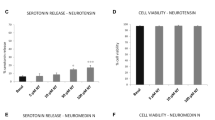Abstract
Bradykinin, kallidin (Lys-bradykinin) and [Thi5,8,d-Phe7]-bradykinin a functional B2 antagonist, induce histamine release from rat peritoneal mast cells. The histamine release is dependent upon added calcium when mast cells are placed in calcium-free medium 30 min before being triggered with the kinins. Histamine release was dose-dependently inhibited by pertussis toxin (1–100 ng/ml) and by benzalkonium chloride (0.1–3 μg/ml). The efficiency of ionophore A23187 on histamine release was affected neither by pertussis toxin nor by benzalkonium chloride. The parallel responses of rat peritoneal mast cells to kinins and to substance P suggest that these peptides have the same mechanisms of action i.e. activation of a pertussis toxin-sensitive G protein and of phospholipase C defining a peptidergic triggering pathway of mast cells.
Similar content being viewed by others
References
M. Mousli, C. Bronner, J. L. Bueb, E. Tschirhart, J. P. Gies and Y. Landry,Activation of rat peritoneal mast cells by substance P and mastoparan. J. Pharmacol. exp. Ther.250, 329–335 (1989).
P. Devillier, M. Renoux, G. Drapeau and D. Regoli,Histamine release from rat peritoneal mast cells by kinin antagonists. Eur. J. Pharmacol.149, 137–140 (1988).
I. D. Lawrence, J. A. Warner, V. L. Cohan, L. M. Lichtenstein, A. Kagey-Sobotka, R. J. Vavrek, J. M. Stewart and D. Proud,Induction of histamine release from human skin mast cells by bradykinin analogs. Biochem. Pharmacol.38, 227–233 (1989).
D. Regoli and J. Barabé,Pharmacology of bradykinin and related kinins. Pharmacol. Rev.32, 1–46 (1980).
G. W. Read and E. F. Kiefer,Benzalkonium chloride: selective inhibitor of histamine release induced by compound 48/80 and other polyamines. J. Pharmacol. exp. Ther.211, 711–715 (1979).
M. A. Lowman, R. C. Benyon and M. K. Church,Characterization of neuropeptide-induced histamine release from human dispersed skin mast cells. Br. J. Pharmacol.95, 121–130 (1988).
F. L. Pearce, T. A. Kassessinoff and W. L. Liu,Characteristics of histamine secretion induced by neuropeptides: implications for the relevance of peptide-mast cell interactions in allergy and inflammation. Int. Arch. Allergy appl. Immunol.88, 129–131 (1989).
C. Bronner, J. P. Gies, A. Vallé and Y. Landry,Preservation of the secretory response of peritoneal mast cells in the absence of extracellular calcium. Life Sci.41, 2555–2562 (1987).
Author information
Authors and Affiliations
Rights and permissions
About this article
Cite this article
Bueb, J.L., Mousli, M., Landry, Y. et al. A pertussis toxin-sensitive G protein is required to induce histamine release from rat peritoneal mast cells by bradykinin. Agents and Actions 30, 98–101 (1990). https://doi.org/10.1007/BF01969009
Issue Date:
DOI: https://doi.org/10.1007/BF01969009




